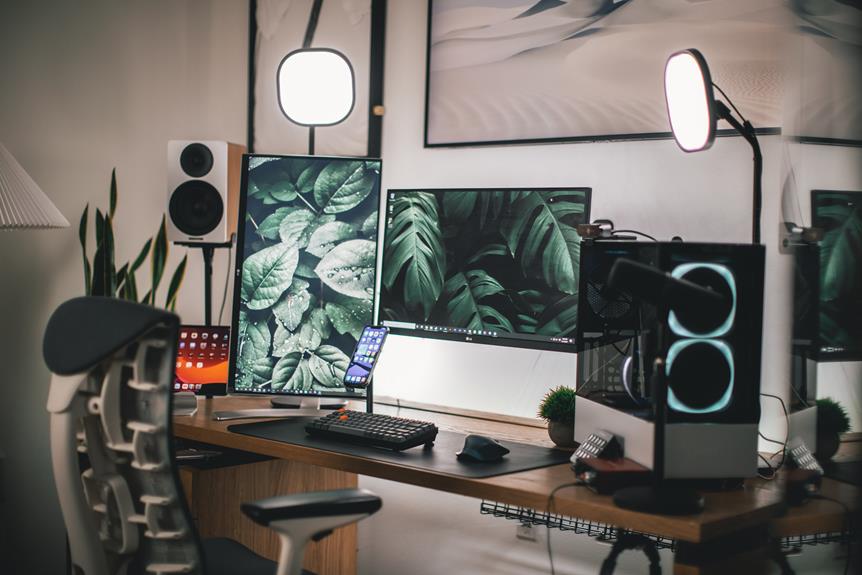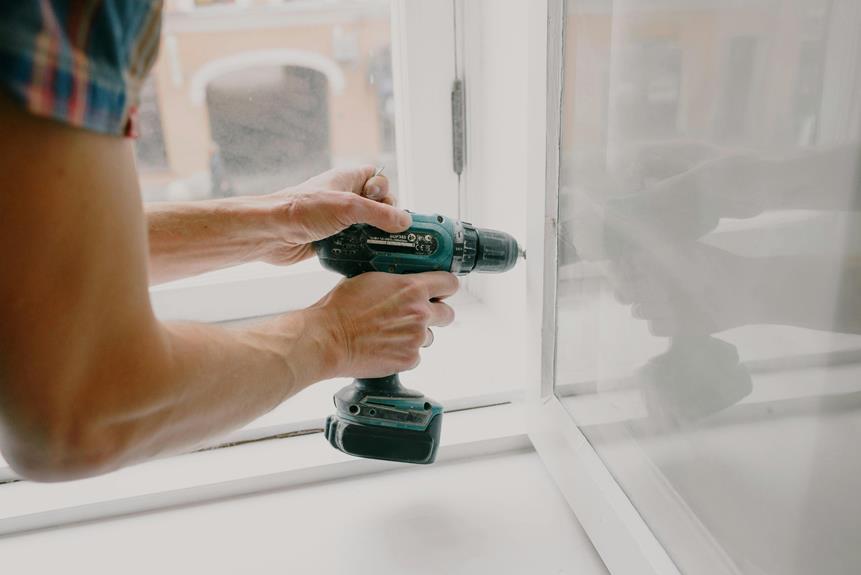With the rise of remote work and online businesses, creating an efficient and productive home office setup has become essential for many individuals. However, setting up a home office can be costly, and budgeting for this endeavor is crucial.
Whether you’re a freelancer, remote worker, or just need a productive space, these thirteen tips will guide you in creating an efficient and cost-effective home office setup.
From assessing your needs to finding affordable ergonomic solutions, we’ve got you covered. So grab a cup of coffee and get ready to transform your space into a haven of productivity – because your dream home office is just a few hacks away.

Evaluate Your Current Office Needs
To find the best home office setup for your needs, start by evaluating your current office and identifying areas that can be improved. Take a close look at your setup and ask yourself if it meets your requirements. Is your current space comfortable to work in?
Is it organized and conducive to productivity? Assess the furniture, lighting, and overall layout of your office. Consider any necessary upgrades that would enhance your work environment.
Think about the specific tasks you perform in your home office. Do you need more storage for files and supplies? Would a larger desk or a more comfortable chair improve your productivity?
Evaluate the technology you use, such as your computer, printer, and internet connection. Are they reliable and efficient? If not, determine the necessary upgrades to meet your needs.
Set a Realistic Budget
When setting up your home office, it’s important to create a budget that aligns with your financial goals and allows for necessary expenses. Setting a realistic budget is crucial to ensure that you don’t overspend or compromise on the quality of your office setup. Here are some strategies to help you stay within your budget while creating a functional and productive workspace:
- Prioritize needs over wants: Focus on essential office supplies and furniture before considering any extras. This will help you stay on track with your budget and avoid unnecessary expenses.
- Research and compare prices: Take the time to research and compare prices for office supplies and equipment. Look for sales and discounts to get the best deals. Additionally, consider opting for refurbished or second-hand furniture, as they can be cost-effective alternatives.
- Set a budget limit for each item: Determine how much you’re willing to spend on each office item and stick to that budget. This will help you avoid overspending and make more conscious purchasing decisions.
- Consider long-term savings: Look for energy-efficient lighting and equipment options that can help you save on electricity bills in the long run. Additionally, utilize online resources and digital tools for organization and productivity, as they often offer free or low-cost alternatives.
Prioritize Essential Office Equipment
Prioritizing essential office equipment for your home office setup is crucial. Consider the tools and devices that are necessary for your specific work tasks. It’s important to invest in items that will enhance your productivity and comfort, while also being cost-effective.
Here are three essential office equipment items to prioritize for your home office:
- Ergonomic Chair: A comfortable and supportive chair is crucial for long hours of work. Look for a chair that provides proper back support and adjustable features, allowing you to customize it to your preferences. This will promote good posture and reduce the risk of strain and discomfort.
- Functional Desk: A sturdy and spacious desk is essential for your home office. Consider the size and layout of your workspace, and choose a desk that fits your needs. Look for one with ample storage options, such as drawers or shelves, to keep your essentials organized and within reach. A well-organized workspace can boost efficiency and help you stay focused.
- Reliable Technology: Invest in quality and reliable technology, such as a fast and efficient computer or laptop, a stable internet connection, and a printer/scanner if needed. These tools are essential for completing your work tasks smoothly and efficiently.
Consider Second-Hand or Refurbished Options
Save Money by Considering Second-Hand or Refurbished Options for Your Home Office
When setting up your home office, it’s important to find cost-effective solutions that still meet your needs. One way to save money without compromising quality is by exploring second-hand or refurbished options for your office equipment.
These alternatives can provide you with the functionality you require at a fraction of the cost. Buying second-hand equipment can be a smart choice as it often comes at a lower cost and offers a wide variety of options to choose from. You can find quality equipment that suits your needs while saving money in the process.
Refurbished equipment is another great option. These items undergo a thorough inspection and repair process, ensuring their quality and functionality. Additionally, many refurbished products come with warranties or guarantees, giving you peace of mind.
To help you navigate the world of second-hand or refurbished office equipment, a buying guide can provide expert advice, compare different options, and even offer tips for negotiating prices. With the help of this guide, you can make informed decisions and find the best equipment for your home office setup.
Optimize Your Workspace Layout
Maximizing the efficiency of your home office setup involves strategically arranging your workspace layout. An organized and ergonomic workspace can greatly enhance your productivity and overall work experience. Here are three tips to optimize your workspace layout and create a space that boosts productivity and a sense of belonging:
- Choose Comfortable Furniture: Invest in a comfortable chair and an adjustable desk that allows you to maintain proper posture while working. A chair with lumbar support and adjustable height can help reduce back pain. Similarly, an adjustable desk lets you switch between sitting and standing positions, preventing fatigue and promoting better blood circulation.
- Personalize Your Space: Surround yourself with items that inspire and motivate you. Whether it’s a favorite quote, a picture of loved ones, or a plant that adds a touch of nature to your workspace, personalizing your space can help create a sense of belonging and make your home office feel more inviting.
- Keep It Tidy: Organize and declutter your workspace to minimize distractions. Utilize desk organizers, cable management solutions, and storage options to keep your supplies, documents, and equipment neatly arranged. A clutter-free workspace improves focus and gives a sense of control and peace of mind.
Utilize Free or Low-Cost Software Solutions
Take advantage of the wide range of free or low-cost software solutions available to enhance the functionality and productivity of your home office setup. By exploring software alternatives and open-source options, you can find powerful tools that won’t break the bank.
When it comes to office productivity, there are plenty of free software solutions that can help you stay organized, manage your tasks, and collaborate with others.
For example, tools like Trello, Asana, or Todoist can help you create and manage to-do lists, track your progress, and stay on top of deadlines. These tools have user-friendly interfaces and can be easily accessed from your computer or mobile device.
If you’re looking for office suite alternatives to expensive software like Microsoft Office, consider using open-source options like LibreOffice or Google Docs. These platforms offer similar functionality to their paid counterparts, including word processing, spreadsheet creation, and presentation design. They also allow for easy collaboration and file sharing with colleagues.
In addition to productivity tools, there are also free or low-cost software solutions available for creative tasks. For graphic design, consider using open-source software like GIMP or Inkscape. These programs offer powerful image editing and vector graphics capabilities, allowing you to create stunning visuals for your business.
Explore DIY Storage and Organization Ideas
Make your home office setup more efficient with these DIY storage and organization ideas. Keeping your workspace tidy is crucial for productivity and a sense of belonging. Here are three organization hacks that will help you maximize your space and repurpose furniture:
- Give your old bookshelves a new purpose: Instead of buying new storage units, repurpose your old bookshelves for a functional and stylish storage solution. Paint them in a color that matches your office decor and add baskets or bins to keep your supplies organized.
- Transform a pegboard into a wall organizer: Install a pegboard on one of your office walls and use it to hang various office supplies like scissors, sticky notes, and even small plants. This simple DIY project won’t only declutter your desk but also add a touch of personality to your workspace.
- Create a desk organizer from cereal boxes: Cut and glue cereal boxes together to create compartments for your pens, notepads, and other small office supplies. You can cover them with decorative paper or fabric to match your office decor. This budget-friendly DIY organizer will keep your desk tidy and give you a sense of accomplishment.
Take Advantage of Online Deals and Discounts
Now that your home office is organized and efficient, it’s time to save even more money by taking advantage of online deals and discounts.
Online shopping has become increasingly popular, and with a little bit of research and savvy, you can find some incredible deals that will help you stay within your budget.
To find the best online deals, here are a few tips to keep in mind.
Sign up for newsletters and email alerts from your favorite retailers. They often send out exclusive discounts and promo codes to their subscribers. Follow your favorite brands and stores on social media. They frequently post about flash sales and limited-time offers that you won’t want to miss.
Another tip is to use comparison websites and apps. These platforms allow you to compare prices from different sellers and find the best deal available. You can also set price alerts for specific products, so you’ll be notified when the price drops.
Don’t forget to check out online marketplaces and auction sites. These platforms often have great deals on both new and used items. Just be sure to read the seller’s reviews and check their return policy before making a purchase.
By taking advantage of these online deals and discounts, you can save money while still getting the items you need for your home office.
Compare Prices and Read Customer Reviews
When setting up your home office, it’s important to make informed purchasing decisions. One key step is to compare prices and read customer reviews. This helps ensure that you get the best value for your money and avoid any potential regrets.
Let’s explore three reasons why comparing prices and reading customer reviews is crucial for your home office setup.
Comparing prices allows you to find the best deals and discounts available for the items you need. This not only helps you save money but also gives you a sense of satisfaction knowing that you’ve made a smart purchase. Instead of blindly buying the first thing you see, take the time to compare prices and make an informed decision.
Reading customer reviews provides valuable insights into the quality and performance of a product. By learning from the experiences of others, you can make more informed decisions.
It’s like being part of a community of like-minded individuals who’ve already tried and tested the product. This sense of belonging can help you feel more confident in your choices.
Lastly, when comparing prices, it’s essential to consider alternative options such as second-hand or refurbished items. These options can often be more affordable while still maintaining high quality.
Look for Budget-Friendly Ergonomic Solutions
When setting up your home office on a budget, it’s important to prioritize comfort and support. To help you find affordable ergonomic solutions, here are some budget-friendly chair options and standing desk solutions to consider:
- ErgoMesh Office Chair: Priced between $100 and $150, this chair features breathable mesh and lumbar support for optimal comfort.
- Adjustable Task Chair: With a price range of $80 to $120, this chair allows you to adjust both the height and backrest to find the perfect position for you.
- Ergonomic Gaming Chair: Priced between $150 and $200, this chair offers a cushioned seat and adjustable armrests for added comfort during long hours of work.
- Folding Office Chair: With a price range of $50 to $80, this chair is space-saving and lightweight, making it easy to move and store when needed.
- Balance Ball Chair: Priced between $60 and $90, this chair promotes core strength and good posture while providing a comfortable seating option.
For standing desk solutions, consider the following options:
- Adjustable Standing Desk: Priced between $150 and $200, this desk allows you to adjust the height and provides a spacious workspace for your needs.
- Desk Riser Converter: With a price range of $80 to $120, this converter allows you to transform your existing desk into a standing desk, promoting a healthier work style.
- Wall-Mounted Standing Desk: Priced between $100 and $150, this desk saves space and is easy to install, providing a functional and ergonomic workspace.
- DIY Standing Desk: With a price range of $50 to $80, you can create your standing desk using affordable materials and personalizing it to your preferences.
- Portable Standing Desk: Priced between $40 and $70, this lightweight desk is adjustable in height and can be easily moved around, offering flexibility in your workspace setup.
Plan for Future Upgrades and Expansions
When planning for the future growth of your home office setup, it’s important to consider long-term upgrades and expansions. By anticipating the needs of your expanding business or changing work requirements, you can ensure that your workspace remains functional, efficient, and comfortable.
Here are three strategies to help you plan for future expansion plans:
- Invest in modular furniture: Opt for furniture that can be easily reconfigured or expanded as your needs change. Modular desks, shelves, and storage units offer flexibility and adaptability, allowing you to customize your workspace without overspending.
- Upgrade your technology gradually: Instead of splurging on the latest gadgets and equipment all at once, consider upgrading your technology gradually. Start by prioritizing the tools that will have the most immediate impact on your productivity. This approach allows you to spread out the cost and make informed decisions based on your evolving requirements.
- Create a dedicated expansion fund: Set aside a portion of your budget specifically for future upgrades and expansions. By regularly contributing to this fund, you can accumulate the necessary resources to invest in improvements when the time comes. This proactive approach will give you peace of mind knowing that you have a financial buffer for future growth.
Conclusion
As you finish budgeting for your home office setup, remember that each step you take is like a brushstroke on the canvas of your productivity. Just like a painter carefully chooses their colors, you have carefully selected the essential equipment, optimized your workspace, and planned for future upgrades.
By embracing these budget-friendly tips, you have created a space that symbolizes efficiency, comfort, and inspiration. Now, it’s time to unleash your creativity and enjoy the fruitful results of your hard work.










